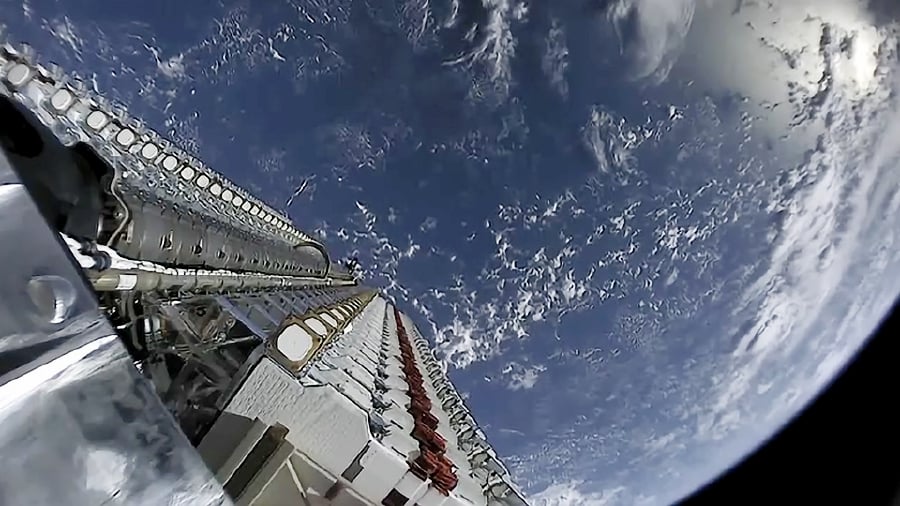
Published in Astro Awani, New Straits Times, and Asia News Today, image by New Straits Times.
Starlink is a division within SpaceX—the company headed by the richest man in the world, Elon Musk, that designs, manufactures and launches advanced rockets and spacecraft—providing satellite internet connectivity around the world using thousands of small satellites in space.
As Starlink’s representatives were reported to be in Malaysia this week [week of the 23rd May] for further discussions, we hope the government takes into account various crucial factors before making any deals.
Starlink’s Current Value Propositions: Speed and coverage
Starlink uses low-Earth orbiting (LEO) satellites at about 300 miles (550km) above the earth’s surface, giving it the advantage of relatively higher speeds and lower latency.
Download speeds have been reported in the range of 100Mbps to 200Mbps with latency between 20 to 40 milliseconds based on user feedback as reported by the technology site and review portal, PCMag. Starlink also offers a premium service with download speeds up to 500 Mbps. These are comparable to home fibre internet.
Starlink aims to have a constellation of about 40,000 satellites in the future to ensure global coverage and constant connectivity.
Should Malaysia Care About Starlink’s Potential Offerings?
The short answer is a “cautious yes”.
As mentioned by former CEO of Jaring Communications Dr Mohamed Awang Lah in a Free Malaysia Today article, the biggest challenge for Malaysia’s broadband connectivity in rural areas is the high cost of backhaul infrastructure.
This refers to the connectivity from a point-of-presence (POP) of a service provider to the fibre “backbone” of the internet core network, which could be a long distance. The distance is especially large when referring to rural areas, resulting in non-cost-effective service delivery.
Foregoing the need for long-distance ground infrastructure, satellite internet such as Starlink has the potential to provide the backhaul services in rural areas, filling this economic and technical gap.
Thus, at present technology levels, target market and price points, Starlink could be said to complement ground fibre and 5G, especially in remote areas.
Key Variables to Consider
Even though conceptually straightforward, there are complex economic, geographical, meteorological, technical, business and even geopolitical variables for the government to consider.
At present, Starlink ‘s consumer price points could make sense for high-income remote towns or cities with low population densities, but may not be affordable for private, low-income earners, living in rural areas.
Sources indicate Starlink’s rate to be around US$110 (MYR 484) a month, with a one-off US$599 (MYR 2,634) fee for the user terminal i.e., the satellite dish and router.
For faster speeds and better connections, a Premium Starlink service can cost US$500 (MYR 2,199) a month with a one-off US$2,500 (MYR 10,994) fee for the terminals.
Should prices offered to Malaysia (or by re-sellers to customers) be within the range stated, then clearly it would not be affordable even for a lot of urban dwellers—what more for rural folks in both East and West Malaysia?
The government needs to conduct an in-depth cost-benefit analysis to compare propositions by local telecommunication companies (telco) or local agencies in bringing internet connectivity to rural areas in terms of timeline, coverage, speed, reliability, costs, and prices.
At present, Starlink services require ground stations, or gateways, that are linked to ground fibre optic infrastructure. A Starlink user’s home dish links up to a Starlink satellite, which would then connect to the nearest gateway, thus connecting the subscriber to the internet.
Therefore, depending on the location, there could still be a need for local players to set up fibre optic infrastructure to interface with Starlink’s gateway system.
However, given that these gateways can be within 500 miles (804 km) of the subscriber’s location for internet service to be available, it may cost substantially less than building terrestrial infrastructure down to the last mile POP.
Geography and Meteorology
Said gateways require a clear 360-degree view of the sky giving it access to the minimum elevation angles of the satellites, which could be challenging with the undulating, mountainous, plantation or vegetation-filled terrains that are common in Malaysia, particularly in East Malaysia where rural connectivity is in a dire situation.
As for the subscriber’s dish, the same type of terrain may present challenges in having constant connectivity with the satellites. When a satellite moves below a certain angle (its elevation angle) or is obstructed by trees, hills or mountains, the signal could be lost.
Thus, authorities must consider the variables of terrain and elevation angle in the targeted areas to determine internet connection reliability. How long and how frequent are the potential downtimes for the users?
These estimates must consider Starlink’s plan to add many more satellites in orbit, which might be able to reduce, if not eliminate the potential downtime issue due to obstructions or elevation angles.
The practicality of trimming vegetations, land clearings, and removing or bypassing obstructions such as putting the dishes on elevated poles for each of these communities and/or individual users in the rural areas is a real question of cost and practicality.
The impact of Malaysia’s heavy downpour, tropical storms and high atmospheric moisture content on signal attenuation, electromagnetic interference and/or disruption to connectivity must be studied over a sufficient duration to generate data to see if Malaysia can truly reap the value from Starlink.
Should these variables prove significant, then the government should consider other options, or negotiate prices that reflect the true average speeds and stability. Of course, Starlink may pursue the same price globally and Malaysia’s negotiating power is directly proportional to the market size, which may not be as big as we’d like it to be.
The government could also wait for near-future satellite technologies that communicate with one another using lasers, avoiding the need for ground stations, and overcoming the need for bands that may be susceptible to atmospheric attenuations.
Technical and Business Considerations
Current Starlink technology and potential business model may require local partners to deploy the necessary fibre optic infrastructure to position Starlink’s ground stations (gateways), and perhaps local partners to sell, distribute, install, and maintain user terminals.
The economics must still make sense for the local telco to provide such infrastructure. As mentioned earlier, unless there is significant government intervention such as subsidies, it is unlikely that the market is large enough. The economic or market problem extends to local partners intending to sell (re-sellers), distribute, install and/or service user terminals (the dish and the routers).
Note that the network control centres and ground gateways require constant power supply connectivity, therefore infrastructure would require groundworks to deploy fibre cables, and also power lines. Maintenance and repair works have to budget.
Most importantly, who is paying for these costs? In the end, it does not make sense if it burdens the low-income rural folks, which are supposed to be the beneficiaries of the project.
Governance, Implementation and Reputation
Learning from various implementation weaknesses in Malaysia, the government must open up a transparent tender for any local contracts related to Starlink’s deployment. Only credible and worthy companies must get to deal with SpaceX and win Starlink-related contracts.
Any infrastructure requirement using taxpayer’s money must be spent prudently. There must be proactive efforts to remove the risk of price-fixing by suppliers and middle-men markups along the supply chain, which would otherwise defeat the purpose of rural connectivity by making it not affordable for most.
Not that it’s already cheap to begin with, but such actions would not escape Starlink’s notice as it seeks to increase the size of its user base, and expand its global presence.
If Elon Musk makes negative Tweets to his over 90 million followers regarding any business and political ecosystem issues in Malaysia, it could send waves across the entire investor landscape with serious repercussions in many sectors and across time.
5G versus Starlink
Though Starlink positions itself as a complementing ground-based internet such as 5G or fibre, this is subject to the evolution of technology, and prices.
Presently, Starlink may not be considered a competitor to local telco, especially in the cellular 5G market and in densely-populated urban areas, but as mentioned in an article by BDO—an international network of public accounting, tax and advisory firms—satellite internet and 5G potential markets have a huge overlap.
As satellite internet technology improves in speed, reliability, and scale (therefore, reducing costs), we could see Starlink being used in many sectors that would compete with 5G. Reducing size of user terminals may see cellular devices connected to satellite internet.
Sources indicate that SpaceX has over 2,300 Starlink satellites in orbit, which is impressive and ahead of its competitors, but still far off from its target of over 40,000 satellite constellations. Therefore, we are still in the early stages to grasp Starlink’s full potential.
Starlink’s potential to disrupt the market must not be underestimated. It’s best to ensure that the government has industry experts in its panel of advisors and negotiators when dealing with Starlink to protect national interests.
How should Malaysia approach this?
Subject to what SpaceX has to offer Malaysia, it’s best not to rush the deal, and it is not advisable to start at a large scale and commit itself to one satellite internet provider.
Instead, Malaysia should proceed with testbeds, just as it did when it started a 5G pilot deployment in Kuala Lumpur and Putrajaya.
The testing period provides the opportunity to elucidate many unknowns such as potential interferences with existing local bands, potential connectivity congestion, security of the Starlink’s broadcast to military and other sensitive assets, impact on the environment, the potential health risk of the electromagnetic radiation on people and animals, and socio-business-economic considerations as discussed earlier which should be part of the pilot deployment for Starlink.
There are other key issues such as safety, security, internet sovereignty where the government must consider fair and reasonable regulatory and policy requirements to protect national interest.
Also, just as Ericsson was selected via a tender process for nationwide 5G rollout, Malaysia should keep in mind other competitors to Starlink that are on the horizon such as Amazon’s Project Kuiper, SpaceMobile (joint-venture between Vodafone Group and Rakuten), and similar initiatives from China, Russia, and the EU.
This is not only to ensure Malaysia gets the best deal but also to ensure it can manage geopolitical sensitivities and manage risks through diversification.
The reaction from major powers and corporations in response to Starlink’s proposition is a testament to its game-changing potential, but also shows the complex geopolitics that needs to be navigated.
The government should also consider packaging deals with the setup of rocket launch sites given Malaysia’s proximity to the equator to compete with Indonesia’s proposition for an equatorial spaceport. Subject to environmental impact assessments and acceptance from the locals, East Malaysia could provide competitive sites.
Ameen Kamal is the Head of Science & Technology at EMIR Research, an independent think tank focused on strategic policy recommendations based on rigorous research.

